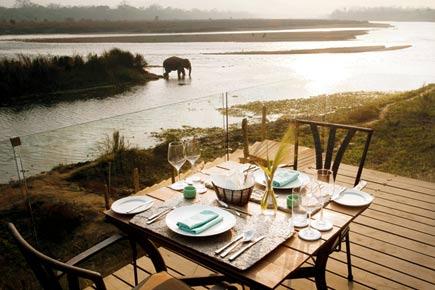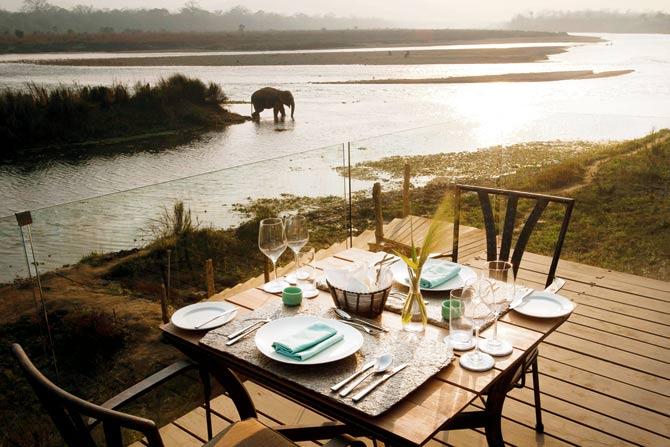The majestic Mt Everest may be every tourist's fantasy. But, spotting the endangered one-horned rhinoceros in the forests of Chitwan in the monsoon can be just as thrilling

 A Sense of serenity washed over us as we adjusted our eyes to a vast, verdant forest stretching in front of us, from the deck of Meghauli Serai, the first international jungle lodge by Taj Safaris at Chitwan National Park in Nepal. To spot the abundant wildlife, the safari options are boat rides, jeep drives, jungle walks and elephant safaris, from atop its two domesticated elephants (we petted and fed the friendly tuskers too).
A Sense of serenity washed over us as we adjusted our eyes to a vast, verdant forest stretching in front of us, from the deck of Meghauli Serai, the first international jungle lodge by Taj Safaris at Chitwan National Park in Nepal. To spot the abundant wildlife, the safari options are boat rides, jeep drives, jungle walks and elephant safaris, from atop its two domesticated elephants (we petted and fed the friendly tuskers too).
ADVERTISEMENT
"We've spotted rhinos right there," Arpita Dutta, a naturalist at the lodge, informed us pointing less than 10-feet away at the banks of Rapti river, where the Greater One-horned Rhinoceros, one of the forest’s famed and painstakingly conserved inhabitants (605 of the 3,000 remaining in the wild are here), often stroll down for a bath. Due to the increase in the river levels during the monsoon, enjoying their company while relishing a lavish Nepalese breakfast by the lodge's cobalt blue swimming pool may sound like a stretch. However, their sightings in the dense forests are possible year-round and monsoon safaris have their own thrill, as we discovered during a luxurious two-night, three-day stay at the four-month-old property — accessible from Kathmandu via a connecting flight to Bharatpur and then, an hour’s drive to Meghauli — with 12 rooms, a presidential suite and 16 villas featuring private plunge pools.

You can spot elephants bathing in the river while enjoying a meal on the deck
Into the wild
Established in 1973, Chitwan, which is Nepal's first national park and now declared a UNESCO World Heritage Site, means 'in the heart of the forest'. The 932 sq-km park is home to more than 68 animals, including the elusive Royal Bengal Tiger, leopards, sloth bear, deer and reptiles and 600 bird species.

A replica of the traditional Tharu village created on the lodge premises
Accompanied by Dutta (who has 15 years of field experience), we made our debut into the wild with a three-hour boat ride down the Rapti river. Considering it was too hot for the crocs to bask on the bank, we only spotted a few pairs of eyes popping out of the water. However, we had a rendezvous with a lovely black-and-white Pied Kingfisher — one of the only two kingfisher varieties that hover over the lakes. Through the ride, Dutta kept us regaled with interesting nuggets — did you know that a Gharial has 120 teeth or that a Streak-Throated Woodpecker can peck 20 times per second?
Look, there’s a rhino… no, six!
The next day, at 6 am (here, the sun rose by 4.30 am), inside the forest, it felt like an Instagram filter had been added, as the browns and the greens of the Sals, Red Silk Cotton and Rhino Apple trees appeared brighter. After 30 minutes of an undulating drive, Dutta suddenly motioned the driver to halt and a hush fell among the guests (a family of four had accompanied us for this drive). She excitedly told us to look in the 9 o’clock direction and there they were! A mother and a baby rhino grazing, with birds feeding off their armour-like hides.
Again, on our way through a thicket that opened into a small pond, we sneaked up on two rhinos wallowing in muddy water. This time, about 10 feet away, they sensed our presence and one of them (a male) stood up, though he didn’t budge from his position. We waited with bated breath for the animal to make its first move. Five minutes later, a mother with a baby in tow, appeared from behind him and disappeared into the trees. Visibly relaxed, the rhino returned to its mud bath, leaving us marvelling at his paternal instinct.
En route, we came across pugmarks, which, Dutta believed were merely three hours old, considering no dust or dew had settled on them. As she painted an adventurous image of a tiger’s lazy strut (judging by the equidistant paw prints) from a nearby watering hole into the forest, we called upon lady luck for a sighting of this predator too.
A vantage view
Nothing compares to the thrill of exploring a forest than atop a pachyderm. We dived and ducked while sitting in a wooden box seat fitted on 35-year-old Saraswati Kali, as the mahout made her wade through the river. While we kept an eye out for the big cat, the naturalist urged us to observe the little moments that brought the jungle alive. We sat transfixed as a dozen Spotted Deer gracefully leapt into the trees in choreographed moves. We met the curious, beady eyes of a Hog fawn that rushed to its mother and spotted a full-grown Sambar (a rare sight here) too. We also found another baby rhino in the four-metre tall elephant grass. When Dutta mimicked its throaty call, the cutie even answered us!
Dine like the Tharus
Mornings spent in the wilderness, and evenings in a majestic bathtub with nibbles from an array of Tharu dishes. Ensconced in the Shivalik and Mahabharat ranges, the inner Terai lowland valleys historically comprised extremely malarial forests, populated only by the Tharus, known to be genetically resistant. Isolated from other parts of the country, the indigenous tribe developed its own culture, traces of which are visible even today, in the bamboo-thatched, Mandala-art decorated mud homes (you can find a replica in the property) or in the simple and mildly-spiced cuisine featuring local ingredients such as snails (boiled and spiced for a delicacy known as Ghonghi), mustard and nettle leaves.
We relished Sishnu Ko Jhor (nettle leaf soup), Aloo-Bodi-Tama Ko Tarkari (a potato veggie with bamboo shoot) and Poka Rice (sticky rice steamed in banana leaf; traditionally cooked in a mud kiln), along with the contrasting, richly-spiced Newari cuisine (native to the urbanised Newars originally living in Kathmandu Valley) which featured the famous Chhoyla (grilled chicken) and Sekuwa Mutton with succulent barbequed meat. A staffer also obliged us with a heavenly sweet concoction locally known as Nighar, a Tharu rice wine (like Chaang) brought from his home kitchen shelf.
And, all too soon, it was time to bid adieu to the lodge and its staff, which we did in typical Taj fashion — excitedly waving both hands in the air.
 Subscribe today by clicking the link and stay updated with the latest news!" Click here!
Subscribe today by clicking the link and stay updated with the latest news!" Click here!






